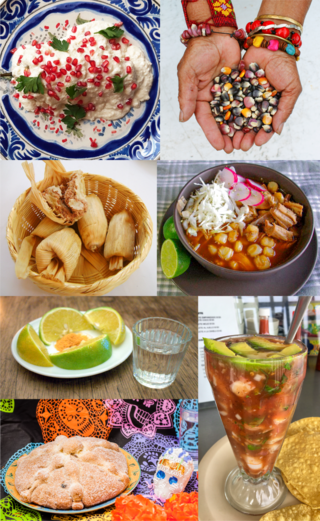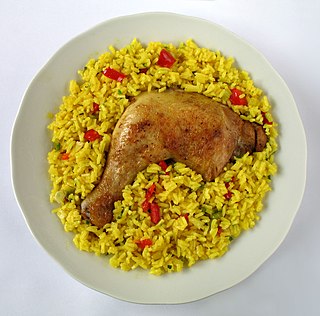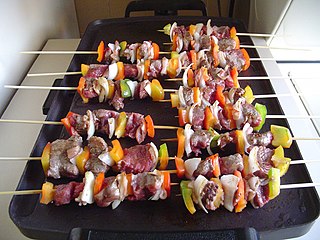Related Research Articles

Mexican cuisine consists of the cooking cuisines and traditions of the modern country of Mexico. Its earliest roots lie in Mesoamerican cuisine. Mexican cuisine ingredients and methods begin with the first agricultural communities such as the Olmec and Maya who domesticated maize, created the standard process of nixtamalization, and established their foodways. Successive waves of other Mesoamerican groups brought with them their cooking methods. These included: the Teotihuacanos, Toltec, Huastec, Zapotec, Mixtec, Otomi, Purépecha, Totonac, Mazatec, Mazahua, and Nahua. With the Mexica formation of the multi-ethnic Triple Alliance, culinary foodways became infused.

The pinto bean is a variety of common bean. In Spanish they are called frijoles pintos. It is the most popular bean by crop production in Northern Mexico and the Southwestern United States, and is most often eaten whole, or mashed and then refried. Prepared either way, it is a common filling for burritos, tostadas, or tacos in Mexican cuisine, also as a side or as part of an entrée served with a side tortilla or sopaipilla in New Mexican cuisine.

Chow mein is a dish of Chinese stir-fried noodles with vegetables and sometimes meat or tofu. Over the centuries, variations of chǎomiàn were developed in many regions of China; there are several methods of frying the noodles and a range of toppings can be used. It was introduced in other countries by Chinese immigrants. The dish is popular throughout the Chinese diaspora and appears on the menus of most Chinese restaurants abroad. It is particularly popular in India, Nepal, the UK, and the US.

Refried beans is a dish of cooked and mashed beans that is a traditional staple of Mexican and Tex-Mex cuisine, although each cuisine has a different approach when making the dish. Refried beans are also popular in many other Latin American countries. The English "refried beans" is a mistranslation, since the essence of "frijoles refritos" is the reheating and mashing of the beans.

Cuban cuisine is largely based on Spanish cuisine with influence from Taino, African and other Caribbean cuisines. Some Cuban recipes share spices and techniques with Spanish, Taino and African cooking, with some Caribbean influence in spice and flavor. This results in a blend of several different cultural influences. A small but noteworthy Chinese influence can also be accounted for, mainly in the Havana area. There is also some Italian influence. During colonial times, Cuba was an important port for trade, and the Spanish ancestors of Cubans brought with them the culinary traditions of different parts of Spain.

The black turtle bean is a small, shiny variety of the common bean especially popular in Latin American cuisine, though it can also be found in the Cajun and Creole cuisines of south Louisiana. Like all varieties of the common bean, it is native to the Americas, but has been introduced around the world. It is also used in Indian cuisine, Tamil cuisine, where it is known as karuppu kaaramani and in Maharashtrian cuisine, where it is known as Kala Ghevada. It is widely used in Uttrakhand India also known as "Bhatt". It is a rich source of iron and protein. The black turtle bean is often simply called the black bean, although this terminology can cause confusion with at least three other types of black beans.

Moros y Cristianos is a traditional Cuban dish served both in homes and in restaurants. It is the Cuban version of rice and beans, a dish found throughout Latin America, the Caribbean, and in the Southern United States.

New Mexican cuisine is the cuisine of the Southwestern US state of New Mexico. The region is primarily known for its fusion of Pueblo Native American cuisine with Hispano Spanish and Mexican cuisine originating in Nuevo México. This Southwestern culinary style is popular beyond the current boundaries of New Mexico, and is found throughout the old territories of Nuevo México and the New Mexico Territory, today the state of Arizona, parts of Texas, and the southern portions of Colorado, Utah, and Nevada.

Frijoles negros is a Latin American dish made with black beans, prepared in Guatemala, Cuba, Venezuela, Puerto Rico, Mexico, and other nations in Latin America. The black bean, a legume of the species Phaseolus vulgaris, is usually purchased in either canned or dried form. One cup of dried black beans yields approximately 2+1⁄2 cups of cooked beans. Black bean soup is another commonly prepared Cuban favorite.

Rice and beans, or beans and rice, is a category of dishes from many cultures around the world, whereby the staple foods of rice and beans are combined in some manner. The grain and legume combination provides several important nutrients and many calories, and both foods are widely available. The beans are usually seasoned, while the rice may be plain or seasoned. The two components may be mixed together, separated on the plate, or served separately.

Carnitas, literally meaning "little meats", in Mexican cuisine, is a dish made by braising, simmering and frying pork in its own fat, lard or cooking oil. The name “Carnitas” is, historically, the vulgar, colloquial name given in Mexico for the French dish Rillons de Tours also known in Spanish as Chicharrón de Tours.

Picadillo is a traditional dish in many Latin American countries including Mexico and Cuba, as well as the Philippines. It is made with ground meat, tomatoes, and also raisins, olives, and other ingredients that vary by region. The name comes from the Spanish word picar, meaning "to mince".

Honduran cuisine is a fusion of Mesoamerican, Spanish, Caribbean and African cuisines. There are also dishes from the Garifuna people. Coconut and coconut milk are featured in both sweet and savory dishes. Regional specialties include sopa de caracol, fried fish, tamales, carne asada and baleadas. Other popular dishes include meat roasted with chismol and carne asada, chicken with rice and corn, and fried fish with pickled onions and jalapeños. In the coastal areas and the Bay Islands, seafood and some meats are prepared in many ways, including with coconut milk. Among the soups the Hondurans enjoy are bean soup, mondongo soup, seafood soups and beef soups. Generally all of these soups are mixed with plantains, yuca, and cabbage, and served with corn tortillas.

Cowboy beans is a bean dish popular in the southwestern United States. The dish consists of pinto beans and ground beef in a sweet and tangy sauce. Other types of meat can be used. A related dish using multiple different types of beans is called calico beans, due to the multiple colors of beans resembling the coat of a calico cat. The flavor is similar to baked beans but with a southwestern twist. Although cowboy appears in the name, the use of canned beans, ketchup, and barbecue sauce means the dish is unlike anything ranch hands would have eaten in the 19th century. Cowboy beans are served stewed or baked, depending on the recipe.

Frijoles charros is a traditional Mexican dish. It is named after the traditional Mexican cowboy horsemen, or charros. The dish is characterized by pinto beans stewed with onion, garlic, and bacon. Other common ingredients include chili peppers, tomatoes, cilantro, ham, sausage, pork and chorizo. It is served warm, and is usually of a soupy consistency.

The cuisine of Veracruz is the regional cooking of Veracruz, a Mexican state along the Gulf of Mexico. Its cooking is characterized by three main influences—indigenous, Spanish, and Afro-Cuban—per its history, which included the arrival of the Spanish and of enslaved people from Africa and the Caribbean. These influences have contributed many ingredients to the cooking including native vanilla, corn and seafood, along with rice, spices and tubers. How much the three mix depending on the area of the state, with some areas more heavily favoring one or another. The state has worked to promote its cuisine both in Mexico and abroad as part of its tourism industry.
Calabacita con puerco is a traditional dish in Mexican cuisine. It consists of pork that is sauteed in butter, oil or in its own fat. Garlic, onion, black pepper, salt and chilis are added, and left on the fire until everything is cooked. Chopped red tomato, corn grains, bay leaf, cumin and black pepper are then added. All this is boiled until the meat is tender. Chopped pumpkin or zucchini is added until finally cooked. This dish is usually served with refried beans and red rice.

Borracho beans, also referred to as drunken beans or frijoles borrachos, is a traditional dish of both Mexican and Southern Texas cuisines made of pinto beans cooked in beer and flavored with cilantro, onion, garlic, bacon, bacon fat, cumin, and chili powder or whole chili peppers. Borracho beans can be served wrapped in tortillas with some form of grilled beef such as carne asada, eaten from a bowl much like chili, or used as a bean dip and eaten with tortilla chips. Variations on this dish in Mexican cuisine often substitute black beans instead of pinto beans.
References
- ↑ "Frijoles Puercos". Food.com. Scripps Networks Interactive . Retrieved 6 July 2015.
- ↑ Diana Kennedy (2014). The Essential Cuisines of Mexico. Potter/Ten Speed/Harmony/Rodale. p. 24. ISBN 9780553419115 . Retrieved 22 October 2018.
- ↑ Marilyn Tausend & Ricardo Muñoz Zurita (2012). La Cocina Mexicana: Many Cultures, One Cuisine. University of California Press. p. 109. ISBN 9780520261112 . Retrieved 22 October 2018.











